A SYSTEMATIC REVIEW OF THE EFFECTS OF PSYCHOTHERAPY ...
A SYSTEMATIC REVIEW OF THE EFFECTS OF PSYCHOTHERAPY ...
A SYSTEMATIC REVIEW OF THE EFFECTS OF PSYCHOTHERAPY ...
Create successful ePaper yourself
Turn your PDF publications into a flip-book with our unique Google optimized e-Paper software.
that participants with increased levels of depression and anxiety were less likely to be involved in<br />
the horsemanship program. In addition, the final hypothesis that behavior and overall conduct<br />
would show positive effects was not supported.<br />
Iannone (2003) also investigated a program for adolescents with emotional difficulties,<br />
who had limited or no success with previous therapy, and predicted that positive changes in<br />
levels of self-esteem, internal locus of control, psychiatric symptoms and behavioral problems<br />
would be noted in relation to time in the program compared with a wait-listed group. In addition,<br />
scores on a vocational skills test were reported as a measure of work-readiness. Statistically<br />
significant increases in self-esteem levels were reported during phase 1 of the three phase<br />
program, with no other significant changes. During phase 2, levels of self-esteem were reported<br />
to continue to increase, and an increasing shift toward external locus of control was noted. No<br />
other significant changes were reported for phase 2. Overall, positive effects on levels of selfesteem<br />
were the only statistically significant results obtained, with no positive results on<br />
psychiatric symptoms and behavior problems noted, and a change in the opposite direction than<br />
was predicted for locus of control. Scores on the vocational skills test did improve, as predicted,<br />
and were in the passing range as defined by the author.<br />
3.1.5. Experimental Study of Efficacy<br />
In a comparison study of the efficacy of an equine-assisted counseling intervention<br />
compared to an award-winning school-based group counseling program (Table 2.6), Trotter,<br />
Chandler, Goodwin-Bond, & Casey (2008) demonstrated statistically significant decreases in<br />
negative behaviors and increases in positive behaviors on five subscales of the BASC Self-<br />
Report Scale, and twelve subscales of the BASC Parent Self-Report for the equine-assisted<br />
counseling experimental group. In contrast, the control group demonstrated statistically significant<br />
decreases in one negative behavior and increases in four positive behaviors on subscales of the<br />
BASC Self-Report Scale, and one item on the BASC Parent Self-Report. Both interventions were<br />
shown to be efficacious, but the experimental equine-assisted counseling group demonstrated<br />
more positive gains and was judged to be superior to the control school-based intervention.<br />
36
















